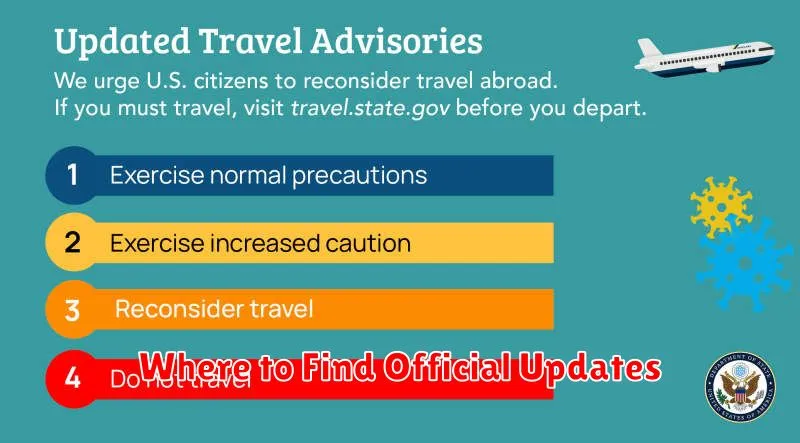Planning a trip abroad? Staying informed about travel alerts and travel advisories is crucial for your safety and well-being. Understanding the difference between a travel alert and a travel advisory can significantly impact your travel decisions, from choosing your destination to preparing for potential risks. This article will provide a comprehensive guide to navigating the complexities of travel alerts and advisories, equipping you with the knowledge to make informed choices and ensure a smooth and secure travel experience.
Travel alerts and travel advisories are issued by governments to inform citizens about safety and security concerns in specific destinations. They offer valuable insights into potential risks, ranging from political instability and natural disasters to health concerns and acts of terrorism. By understanding the distinct meanings of travel alerts and travel advisories, and knowing where to find this crucial information, you can proactively mitigate risks and travel with confidence. Learn how to decipher these important notices and embark on your journeys prepared and informed.
What Are Travel Alerts and How They Work
Travel alerts are official statements issued by governments to inform citizens about short-term, specific security threats in a particular country or region. These threats are typically unpredictable events, such as civil unrest, natural disasters, or terrorist attacks. Travel alerts recommend increased caution and vigilance when traveling to the affected area. They may also suggest postponing non-essential travel depending on the severity and nature of the threat. Unlike travel advisories, alerts are typically short-lived and address specific incidents.
Travel alerts work by providing travelers with actionable information. This information can include specifics about the threat, impacted areas, recommended precautions, and contact information for emergency services. Governments disseminate travel alerts through various channels, including websites, social media, and direct notifications to enrolled citizens. By staying informed about travel alerts, travelers can make more informed decisions about their travel plans and take necessary steps to ensure their safety and security abroad. They also serve as a crucial communication tool, keeping travelers aware of evolving situations and potential risks.
Where to Find Official Updates

Staying informed about travel alerts and advisories is crucial for a safe and smooth trip. Official government resources are the most reliable sources for this critical information.
In the United States, the Department of State provides travel advisories for every country worldwide. These advisories offer valuable insights into safety and security concerns, ranging from crime and terrorism to health risks and political instability.
The Centers for Disease Control and Prevention (CDC) offers health-related travel notices, focusing on disease outbreaks and recommended vaccinations. Consulting both the Department of State and the CDC before your trip is highly recommended.
Many countries also have their own official government websites that provide travel information and safety updates for their citizens traveling abroad. Check your country’s official government website for relevant travel information specific to your nationality.
Types of Advisories: Weather, Political, Health
Travel advisories are issued to inform travelers about potential risks and disruptions. They are categorized into different types based on the nature of the threat. Understanding these distinctions helps travelers make informed decisions.
Weather advisories warn about severe weather conditions, such as hurricanes, blizzards, or extreme heat. These advisories often include information about potential impacts on travel, including airport closures and road conditions. Heeding these warnings is crucial for personal safety.
Political advisories alert travelers to political instability or civil unrest in a specific region. These may include warnings about protests, demonstrations, or increased crime rates. Travelers should carefully consider the potential risks before visiting affected areas and monitor the situation closely.
Health advisories address public health concerns, including disease outbreaks and pandemics. These advisories often provide information about recommended vaccinations, preventative measures, and local healthcare resources. Travelers should consult with healthcare professionals and consider the potential health risks before, during, and after their trip.
How to Respond to Changing Conditions

Monitoring conditions at your destination, both before and during travel, is crucial. Pay close attention to official sources like government websites and local news outlets for up-to-date information.
If conditions change significantly, flexibility is key. Consider adjusting your itinerary or travel dates if possible. Contact your airline, hotel, or tour operator to discuss potential changes or cancellations.
Have a contingency plan. This includes identifying alternative transportation options, accommodations, and communication methods. Pack essential supplies like medication, first-aid kits, and extra cash. Ensure you have copies of important documents like passports and travel insurance.
Staying informed and connected is essential. Enroll in travel advisory programs, such as the Smart Traveler Enrollment Program (STEP) if you’re a US citizen. This allows your government to contact you in case of emergencies.
Finally, be prepared to follow instructions from local authorities. Their guidance is paramount during emergencies or unexpected events. Stay calm and follow directions to ensure your safety.
Travel Insurance and Alert Zones
Travel insurance plays a crucial role when navigating travel alerts and advisories. Before purchasing a policy, understand how your coverage applies to different alert levels. Some policies may not provide coverage for trips to destinations under specific alert levels, particularly those issued due to foreseen events like political instability or natural disasters.
It’s essential to review your policy’s fine print regarding cancellations, interruptions, and medical emergencies in alert zones. Some insurers might offer “cancel for any reason” (CFAR) coverage, providing greater flexibility if an alert is issued before your trip. Be aware of the specific conditions and limitations associated with CFAR options.
Contact your insurance provider directly if an alert is issued for your destination. Discuss your options and document all communication. If you’re traveling to an area already under an alert, ensure your policy covers the associated risks. Proactively seeking information and understanding your policy’s terms can significantly impact your travel experience and financial protection.
Rescheduling or Canceling Safely
When travel alerts or advisories necessitate changes to your plans, it’s crucial to understand your options for rescheduling or canceling safely. Review your travel insurance policy thoroughly. Many policies offer coverage for trip interruptions or cancellations due to unforeseen events, including covered reasons listed in travel advisories. Note the specific terms and conditions, required documentation, and claim filing procedures.
Contact your airline, hotel, and other travel providers immediately. Flexibility and options may vary depending on the provider and the specific circumstances. Some airlines offer waivers for change fees during specific events, allowing you to reschedule your flight without penalty. Hotels might have similar policies in place. Be prepared to provide documentation supporting your need to reschedule or cancel, such as the travel advisory itself.
If your travel arrangements were made through a travel agent or online booking platform, contact them directly. They can assist with navigating the rescheduling or cancellation process and advocate on your behalf with travel providers. Keep records of all communication, including confirmation numbers, email correspondence, and any associated fees or refunds.
Apps That Provide Real-Time Alerts
Staying informed while traveling is crucial for safety and peace of mind. Several apps offer real-time alerts and updates about your destination, ranging from security concerns to natural disasters.
Some apps source their information from government agencies, while others rely on crowdsourced data. Look for apps that provide customizable alerts based on your specific location and interests. Features like offline access to important information and communication capabilities in case of emergencies can also be valuable.
Remember that while these apps offer a valuable service, they are not infallible. It’s always wise to cross-reference information with official government sources and exercise your own judgment when making travel decisions.

